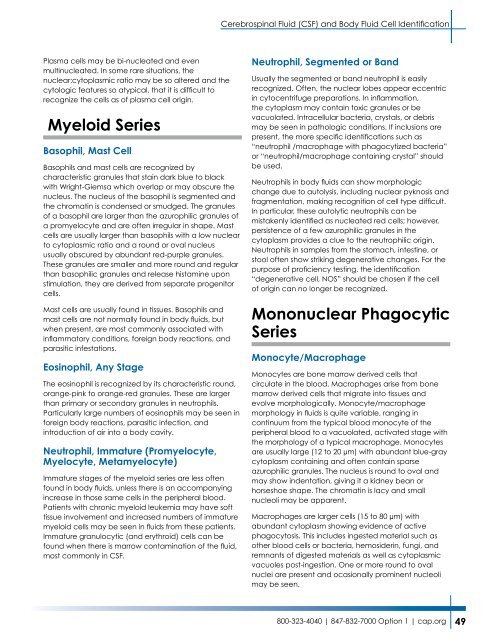Hematology and Clinical Microscopy Glossary - College of American ...
Hematology and Clinical Microscopy Glossary - College of American ...
Hematology and Clinical Microscopy Glossary - College of American ...
Create successful ePaper yourself
Turn your PDF publications into a flip-book with our unique Google optimized e-Paper software.
Plasma cells may be bi-nucleated <strong>and</strong> even<br />
multinucleated. In some rare situations, the<br />
nuclear:cytoplasmic ratio may be so altered <strong>and</strong> the<br />
cytologic features so atypical, that it is difficult to<br />
recognize the cells as <strong>of</strong> plasma cell origin.<br />
Myeloid Series<br />
Basophil, Mast Cell<br />
Basophils <strong>and</strong> mast cells are recognized by<br />
characteristic granules that stain dark blue to black<br />
with Wright-Giemsa which overlap or may obscure the<br />
nucleus. The nucleus <strong>of</strong> the basophil is segmented <strong>and</strong><br />
the chromatin is condensed or smudged. The granules<br />
<strong>of</strong> a basophil are larger than the azurophilic granules <strong>of</strong><br />
a promyelocyte <strong>and</strong> are <strong>of</strong>ten irregular in shape. Mast<br />
cells are usually larger than basophils with a low nuclear<br />
to cytoplasmic ratio <strong>and</strong> a round or oval nucleus<br />
usually obscured by abundant red-purple granules.<br />
These granules are smaller <strong>and</strong> more round <strong>and</strong> regular<br />
than basophilic granules <strong>and</strong> release histamine upon<br />
stimulation, they are derived from separate progenitor<br />
cells.<br />
Mast cells are usually found in tissues. Basophils <strong>and</strong><br />
mast cells are not normally found in body fluids, but<br />
when present, are most commonly associated with<br />
inflammatory conditions, foreign body reactions, <strong>and</strong><br />
parasitic infestations.<br />
Eosinophil, Any Stage<br />
The eosinophil is recognized by its characteristic round,<br />
orange-pink to orange-red granules. These are larger<br />
than primary or secondary granules in neutrophils.<br />
Particularly large numbers <strong>of</strong> eosinophils may be seen in<br />
foreign body reactions, parasitic infection, <strong>and</strong><br />
introduction <strong>of</strong> air into a body cavity.<br />
Neutrophil, Immature (Promyelocyte,<br />
Myelocyte, Metamyelocyte)<br />
Immature stages <strong>of</strong> the myeloid series are less <strong>of</strong>ten<br />
found in body fluids, unless there is an accompanying<br />
increase in those same cells in the peripheral blood.<br />
Patients with chronic myeloid leukemia may have s<strong>of</strong>t<br />
tissue involvement <strong>and</strong> increased numbers <strong>of</strong> immature<br />
myeloid cells may be seen in fluids from these patients.<br />
Immature granulocytic (<strong>and</strong> erythroid) cells can be<br />
found when there is marrow contamination <strong>of</strong> the fluid,<br />
most commonly in CSF.<br />
Cerebrospinal Fluid (CSF) <strong>and</strong> Body Fluid Cell Identification<br />
Neutrophil, Segmented or B<strong>and</strong><br />
Usually the segmented or b<strong>and</strong> neutrophil is easily<br />
recognized. Often, the nuclear lobes appear eccentric<br />
in cytocentrifuge preparations. In inflammation,<br />
the cytoplasm may contain toxic granules or be<br />
vacuolated. Intracellular bacteria, crystals, or debris<br />
may be seen in pathologic conditions. If inclusions are<br />
present, the more specific identifications such as<br />
“neutrophil /macrophage with phagocytized bacteria”<br />
or “neutrophil/macrophage containing crystal” should<br />
be used.<br />
Neutrophils in body fluids can show morphologic<br />
change due to autolysis, including nuclear pyknosis <strong>and</strong><br />
fragmentation, making recognition <strong>of</strong> cell type difficult.<br />
In particular, these autolytic neutrophils can be<br />
mistakenly identified as nucleated red cells; however,<br />
persistence <strong>of</strong> a few azurophilic granules in the<br />
cytoplasm provides a clue to the neutrophilic origin.<br />
Neutrophils in samples from the stomach, intestine, or<br />
stool <strong>of</strong>ten show striking degenerative changes. For the<br />
purpose <strong>of</strong> pr<strong>of</strong>iciency testing, the identification<br />
“degenerative cell, NOS” should be chosen if the cell<br />
<strong>of</strong> origin can no longer be recognized.<br />
Mononuclear Phagocytic<br />
Series<br />
Monocyte/Macrophage<br />
Monocytes are bone marrow derived cells that<br />
circulate in the blood. Macrophages arise from bone<br />
marrow derived cells that migrate into tissues <strong>and</strong><br />
evolve morphologically. Monocyte/macrophage<br />
morphology in fluids is quite variable, ranging in<br />
continuum from the typical blood monocyte <strong>of</strong> the<br />
peripheral blood to a vacuolated, activated stage with<br />
the morphology <strong>of</strong> a typical macrophage. Monocytes<br />
are usually large (12 to 20 μm) with abundant blue-gray<br />
cytoplasm containing <strong>and</strong> <strong>of</strong>ten contain sparse<br />
azurophilic granules. The nucleus is round to oval <strong>and</strong><br />
may show indentation, giving it a kidney bean or<br />
horseshoe shape. The chromatin is lacy <strong>and</strong> small<br />
nucleoli may be apparent.<br />
Macrophages are larger cells (15 to 80 μm) with<br />
abundant cytoplasm showing evidence <strong>of</strong> active<br />
phagocytosis. This includes ingested material such as<br />
other blood cells or bacteria, hemosiderin, fungi, <strong>and</strong><br />
remnants <strong>of</strong> digested materials as well as cytoplasmic<br />
vacuoles post-ingestion. One or more round to oval<br />
nuclei are present <strong>and</strong> ocasionally prominent nucleoli<br />
may be seen.<br />
800-323-4040 | 847-832-7000 Option 1 | cap.org<br />
49
















